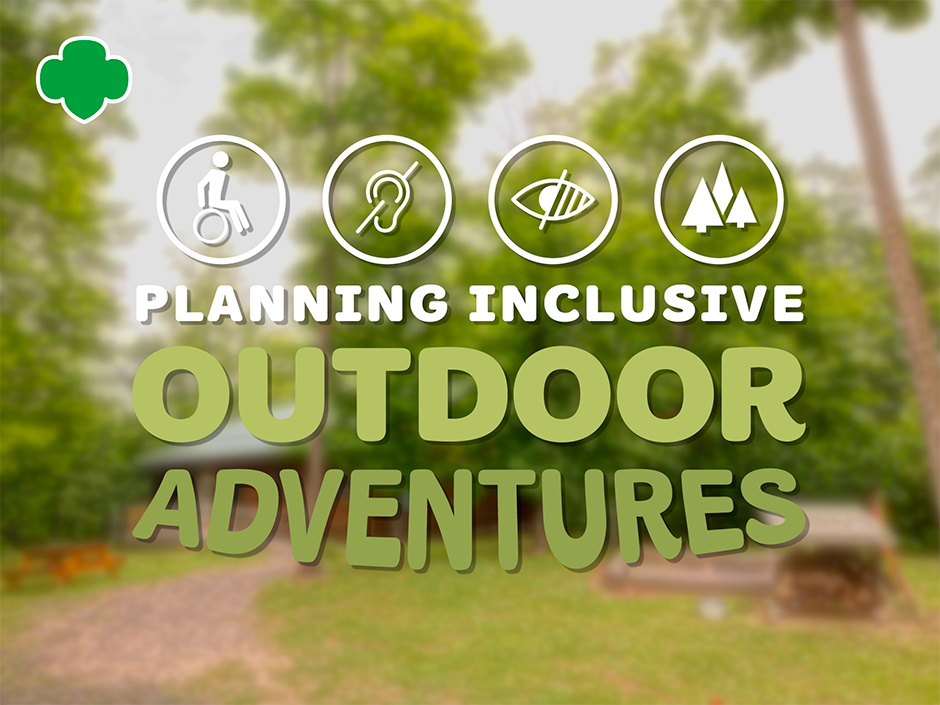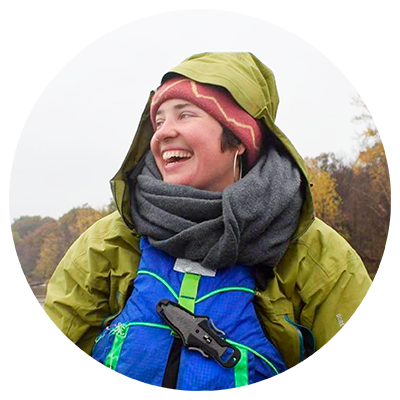 When you picture someone who is adventurous, who comes to mind? Does this person share identities and experiences with the girls in your troop or with yourself? Chances are, they may not. Outdoor adventures are often ranked by who is doing the coolest, most dangerous, and expensive outdoor expeditions, and overlooks the full scope of people who are actually enjoying the outdoors. While outdoor adventures can be cool, dangerous, and expensive, we also need to work to lift up the joy, resilience, and simplicity associated with engaging in the natural world. This is where outdoor inclusion comes into play!
When you picture someone who is adventurous, who comes to mind? Does this person share identities and experiences with the girls in your troop or with yourself? Chances are, they may not. Outdoor adventures are often ranked by who is doing the coolest, most dangerous, and expensive outdoor expeditions, and overlooks the full scope of people who are actually enjoying the outdoors. While outdoor adventures can be cool, dangerous, and expensive, we also need to work to lift up the joy, resilience, and simplicity associated with engaging in the natural world. This is where outdoor inclusion comes into play!
When we talk about outdoor inclusion, what and who are we talking about? We’re talking about creating natural spaces that make everyone feel welcomed and encouraged to partake in outdoor activities—including you and your troop! The push to diversify and make the outdoors more equitable is not new. Many organizations and adventurers have been working hard to change the story of who is welcome and who is visible in natural spaces—now this includes you!
Things to Keep in Mind
Keep it Girl-led
When in doubt, don’t make assumptions about a girl’s interest or ability. Ask the girl and their parent/guardian what their interests and needs are with outdoor activities. Then, brainstorm options with your troop with the framework of keeping everyone involved in whatever way works best for them.
Use Progression to Set and Achieve Goals
Dreaming big is necessary and can be a great goal to work towards. Is your troop interested in a five-day canoe trip in the Boundary Waters Canoe Area? Great! Start with a backyard campout and day-paddle, and work your way towards your goal.
Utilize Universal Design
Universal design is a method of designing an environment (landscape), building, or program so that it can be accessed and used by everyone regardless of their age, ability, or experience.
Earn the Adventure Club Patch
The great thing about the Adventure Club patch is that it meets girls where they are, and lets girls define what “adventure” means to them. Any of the activities listed below would be excellent opportunities to start earning the patch.
Examples of Inclusive Outdoor Activities
Here are three examples of outdoor activities with opportunities to incorporate universal design principles to plan an inclusive outdoor activity for your troop.
Bird Watching
Bird watching or “birding,” can be done almost anywhere at any time. Birding is a great activity to do with your troop to experience the outdoors. The Audubon Society suggests looking for birds near water and to use your senses to spot them. There are many tools to use locate and identify birds, and most can be obtained for free or low-cost. Binoculars are helpful, but not required, and many local and state parks provide free equipment rentals for birding kits. Guidebooks are helpful in identifying birds; check your local library for common books like The Sibley Guide to Birds or National Geographic’s Complete Birds of North America. The Audubon Center also has a free app with over 800 species of North American birds, and includes a tracking device to record all the birds you’ve identified.
All Girl Scouts River Valleys service units are located in the Mississippi Flyway; a route that over 325 birds make from Northern Canada and Minnesota to the wintering grounds, from the Gulf of Mexico to South America. This route offers exceptional birding opportunities in the fall and spring. Birding is not just limited to the Mississippi Flyway—many bird species live year-round in Minnesota, Wisconsin, and Iowa, offering fun outings for your troop no matter the season.
Sensory Gardens
Sensory gardens offer opportunities to interact with the natural world in a safe and accessible environment by encompassing landscaping designed to stimulate the senses. Sensory gardens utilize universal design methods by providing paths accessible to most mobility devices (e.g., wheelchair, braces, stroller, walker, etc.), signage with Braille, and the encouragement of touching plants and garden features that explain human sensory responses (e.g., sight, smell, touch, hearing, taste, etc.). Sensory gardens also help you engage in the natural world while providing opportunities to learn about gardens and senses in a safe, inclusive, and calming atmosphere. Check out two of the sensory gardens around our council: Minnesota Landscape Arboretum in Chaska and Muriel Sahlin Arboretum in Roseville.
Hiking
One of my favorite things about hiking is how versatile and budget-friendly it is. Hiking by definition is a long walk and can be adjusted to whatever works best for your troop. Your troop’s hike can be in a wilderness setting or close to your meeting space. Use our planning tips at the beginning of this post to ensure your hike is inclusive. If your hike needs to be accessible to a mobility device, use TrailLink, an online tool to find wheelchair accessible trails in your area. Additionally, we recommend contacting the park to confirm trail conditions and access since trail conditions will vary from season-to-season.
Hiking in new or familiar areas can offer exciting opportunities for games and learning. Hiking in a park near your meeting space? Make a bingo game to learn about the common flora and fauna in your area. Hiking in a state park? Check out free equipment rentals and locate nearby geocaches.
Inclusive outdoor adventures can vary greatly depending on who is seeking the opportunity, and we’ve only scratched the surface! Interested in learning more about diversifying the outdoors? These additional resources are a great place to continue:
- Include EVERY Girl: 5 Tips on How to Adapt for Disabilities from In the Loop
- Unlikely Hikers
- Disabled Hikers
- Melanin Base Camp & Diversify Outdoors
- Wilderness Inquiry
 Grace Heneghan – Grace is a Program Resources Specialist at River Valleys. She earned her BA in Gender and Women’s Studies and minor in Environmental Studies from Northland College. Her background also includes guiding backcountry expeditions and teaching outdoor education to youth. In her free time, Grace enjoys reading, listening to music, cooking, and exploring the metro area. Three things she can’t live without? Pamplemousse La Croix, a canoe paddle, and a manicure.
Grace Heneghan – Grace is a Program Resources Specialist at River Valleys. She earned her BA in Gender and Women’s Studies and minor in Environmental Studies from Northland College. Her background also includes guiding backcountry expeditions and teaching outdoor education to youth. In her free time, Grace enjoys reading, listening to music, cooking, and exploring the metro area. Three things she can’t live without? Pamplemousse La Croix, a canoe paddle, and a manicure.